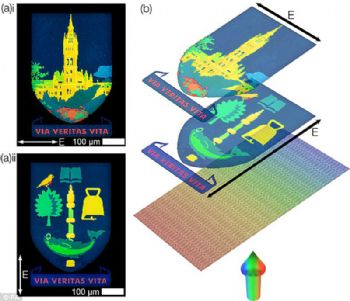
Scientists have developed a new form of high-resolution ‘printing’ that could have wide-ranging applications for data storage, anti-counterfeiting measures, and digital imaging.
New research from the University of Glasgow (
www.gla.ac.uk), published on 20 September in the journal
Advanced Functional Materials, outlines how engineers have developed nano-scale plasmonic colour filters that display different colours depending on the orientation of the light that hits them.
Essentially, this new technique allows the ‘printing’ of two entirely different (but exceptionally detailed) full-colour images within the same surface area — something that has never been done before using ‘structural colour’ techniques.
Instead of relying on dyes and pigments, as in traditional printing, structural colour uses specially structured nano-materials to render colours.
These produce much-higher-resolution prints that do not fade over time. A typical printed image in a magazine might consist of around 300 coloured dots per inch of page (300dpi); printing with structural colour techniques could have a resolution of 100,000dpi — or more.
Biomedical engineering lecturer Alasdair Clark is the lead author of the research paper. He said: “We discovered that if we make colour pixels from tiny cross-shaped indents on a strip of aluminium film, the colour they display becomes polarisation-dependent, allowing us to encode two colours into a single pixel, and then select which colour is displayed by shining different polarisations of light at the surface.
"By changing the size and shape of the nanoscale indent, we can create a wide range of different colours at very high resolutions.”
Dr Clark added: “There are a lot of potential applications for our plasmonic colour technology. It’s ideal for long-term data archiving due to its ultra-high resolution; and because the colours won’t fade, even when exposed long-term to the harshest sunlight, we’ve worked out that we could store 1.46Gb of data per square centimetre — so a single A4 sheet could hold more than 900Gb of data.”